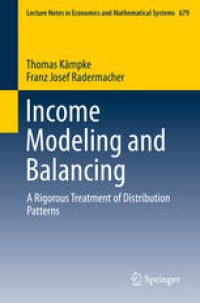
Ebook: Income Modeling and Balancing: A Rigorous Treatment of Distribution Patterns
- Tags: Economic Theory, Economic Policy, Game Theory/Mathematical Methods, Game Theory Economics Social and Behav. Sciences
- Series: Lecture Notes in Economics and Mathematical Systems 679
- Year: 2015
- Publisher: Springer International Publishing
- Edition: 1
- Language: English
- pdf
This book presents a rigorous treatment of the mathematical instruments available for dealing with income distributions, in particular Lorenz curves and related methods. The methods examined allow us to analyze, compare and modify such distributions from an economic and social perspective. Though balanced income distributions are key to peaceful coexistence within and between nations, it is often difficult to identify the right kind of balance needed, because there is an interesting interaction with innovation and economic growth. The issue of justice, as discussed in Thomas Piketty’s bestseller “Capital in the Twenty-First Century” or in the important book “The Price of Inequality” by Nobel laureate Joseph Stiglitz, is also touched on. Further, there is a close connection to the issue of democracy in the context of globalization. One highlight of the book is its rigorous treatment of the so-called Atkinson theorem and some extensions, which help to explain under which type of societal utility functions nations tend to operate either in the direction of more balance or less balance. Finally, there are some completely new insights into changing the balance pattern of societies and the kind of coalitions between richer and poorer parts of society to organize political support in democracies in either case.
Oxford University's Sir Tony Atkinson, well known for his so-called Atkinson theorem, writes in his foreword to the book: “[The authors] contribute directly to the recent debates that are going on in politics. […] with this book the foundation of arguments concerning a proper balance in income distribution in the sense of identifying an ‘efficient inequality range’ has got an additional push from mathematics, which I appreciate very much.”
This book presents a rigorous treatment of the mathematical instruments available for dealing with income distributions, in particular Lorenz curves and related methods. The methods examined allow us to analyze, compare and modify such distributions from an economic and social perspective. Though balanced income distributions are key to peaceful coexistence within and between nations, it is often difficult to identify the right kind of balance needed, because there is an interesting interaction with innovation and economic growth. The issue of justice, as discussed in Thomas Piketty’s bestseller “Capital in the Twenty-First Century” or in the important book “The Price of Inequality” by Nobel laureate Joseph Stiglitz, is also touched on. Further, there is a close connection to the issue of democracy in the context of globalization. One highlight of the book is its rigorous treatment of the so-called Atkinson theorem and some extensions, which help to explain under which type of societal utility functions nations tend to operate either in the direction of more balance or less balance. Finally, there are some completely new insights into changing the balance pattern of societies and the kind of coalitions between richer and poorer parts of society to organize political support in democracies in either case.
Oxford University's Sir Tony Atkinson, well known for his so-called Atkinson theorem, writes in his foreword to the book: “[The authors] contribute directly to the recent debates that are going on in politics. […] with this book the foundation of arguments concerning a proper balance in income distribution in the sense of identifying an ‘efficient inequality range’ has got an additional push from mathematics, which I appreciate very much.”